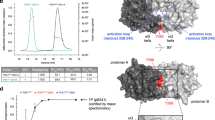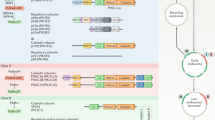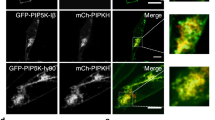Abstract
The protein kinase encoded by the Akt proto-oncogene is activated by phospholipid binding, membrane translocation and phosphorylation. To address the relative roles of these mechanisms of Akt activation, we have employed a combination of genetic and pharmacological approaches. Transient transfection of NIH3T3 cells with wild-type Akt, pleckstrin homology (PH) domain mutants, generated on the basis of a PH domain structural model, and phosphorylation site Akt mutants provided evidence for a model of Akt activation consisting of three sequential steps: (1) a PH domain-dependent, growth factor-independent step, marked by constitutive phosphorylation of threonine 450 (T450) and perhaps serine 124 (S124), that renders the protein responsive to subsequent activation events; (2) a growth factor-induced, PI3-K-dependent membrane-translocation step; and (3) a PI3-K-dependent step, characterized by phosphorylation at T308 and S473, that occurs in the cell membrane and is required for activation. When forced to translocate to the membrane, wild-type Akt and PH domain Akt mutants that are defective in the first step become constitutively active, suggesting that the purpose of this step is to prepare the protein for membrane translocation. Both growth factor stimulation and forced membrane translocation, however, failed to activate a T308A mutant. This, combined with the finding that T308D/S473D double mutant is constitutively active, suggests that the purpose of the three-step process of Akt activation is the phosphorylation of the protein at T308 and S473. The proposed model provides a framework for a comprehensive understanding of the temporal and spatial requirements for Akt activation by growth factors.
This is a preview of subscription content, access via your institution
Access options
Subscribe to this journal
Receive 50 print issues and online access
$259.00 per year
only $5.18 per issue
Buy this article
- Purchase on Springer Link
- Instant access to full article PDF
Prices may be subject to local taxes which are calculated during checkout
Similar content being viewed by others
Author information
Authors and Affiliations
Rights and permissions
About this article
Cite this article
Bellacosa, A., Chan, T., Ahmed, N. et al. Akt activation by growth factors is a multiple-step process: the role of the PH domain. Oncogene 17, 313–325 (1998). https://doi.org/10.1038/sj.onc.1201947
Received:
Revised:
Accepted:
Published:
Issue Date:
DOI: https://doi.org/10.1038/sj.onc.1201947
Keywords
This article is cited by
-
CircSEMA4B inhibits the progression of breast cancer by encoding a novel protein SEMA4B-211aa and regulating AKT phosphorylation
Cell Death & Disease (2022)
-
PERK signaling through C/EBPδ contributes to ER stress-induced expression of immunomodulatory and tumor promoting chemokines by cancer cells
Cell Death & Disease (2021)
-
Metformin alleviates inflammation through suppressing FASN-dependent palmitoylation of Akt
Cell Death & Disease (2021)
-
Inhibitory Activities of Ononin on Particulate Matter-induced Oxidative Stress
Biotechnology and Bioprocess Engineering (2021)
-
miRNA-425-5p enhances lung cancer growth via the PTEN/PI3K/AKT signaling axis
BMC Pulmonary Medicine (2020)



